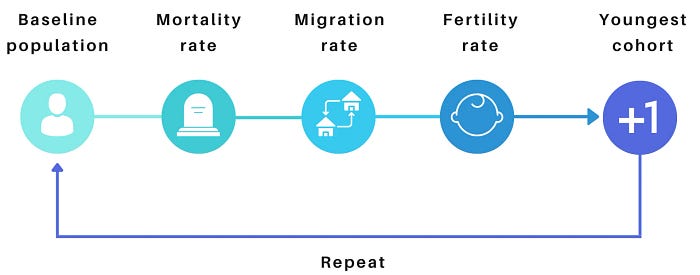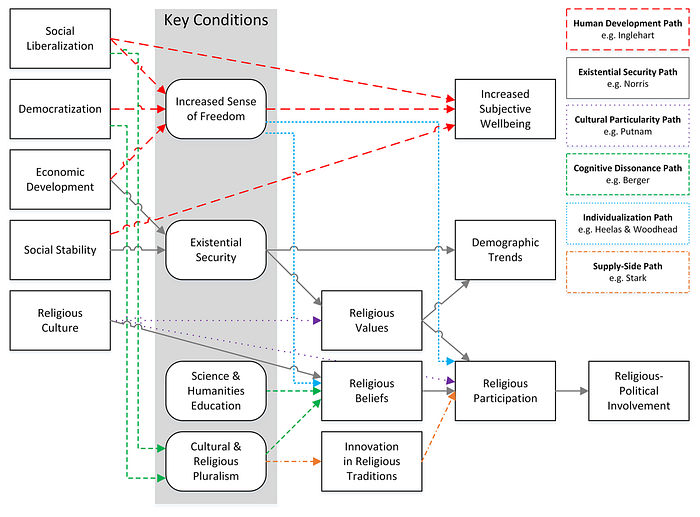Written by Jessie Saeli, edited by Nicole R. Smith and Rachel J. Bacon
Modeling Religious Change combines demography, the scientific study of religion, and computational models to create simulations of religious change in the USA, Norway, and India.
Our research tackles the challenge of creating more accurate projections of religious change in populations by taking account of multiple dimensions of religiosity. Building on our previous projects and traditional methods of creating religious projections, we have created agent-based models which synthesize multiple theories of religious change. The idea is to create artificial societies with cognitively plausible and behaviorally believable AI agents in order to measure the change in religiosity over time.
Starting with data & identity
Religiosity is a multi-dimensional phenomenon. In order to create the databases necessary for our demographic projections, we synthesize vastly different sources of information on (non)religious and spiritual affiliation, practice, and belief. This allows us to create a vivid picture of religious change in various cultural settings from as early as 1900 onward.

The Five Dimensions of Religiosity
In addition to the traditional demographic measures of geographic region, time, sex, and age, we have developed five dimensions to measure religiosity:
- Religious self-identification: self-designated religious affiliation, as indicated by a survey question
- Public religious practice: engagement with a religious community and its rituals, such as religious service attendance
- Private religious practice: engagement with religious practices such as praying, meditating, reading religious materials, making offerings, observing particular diets, or maintaining a personal shrine
- Supernatural worldviews: encompasses belief in invisible religious beings and belief in afterlives of all sorts, not necessarily associated with a particular religion; spirituality
- Subjective importance of religion: the holistic feeling a person has that their religion or spirituality matters to them personally and plays an important role in their daily life
Measuring each of these dimensions comes with its own challenges, but all of the dimensions work together to provide a rich picture of religious change. We synthesize data from multiple sources to increase the amount of data we can use in our models. Our dimensions of religiosity expand and clarify our definition of religion to include multiple levels of religiosity and spirituality.
MRC is focused on capturing the rates at which the dimensions of religiosity have changed over the past century so that we can predict how they will continue to change in the future.
Pushing demographic methods & models
The cohort-component method
The cohort component method (CCM) is commonly used by the government and academia to create the demographic projections used by governments and civic planners. CCM works by applying calculations to cohorts — a group of people who are identified by fixed characteristics based on a starting period — to predict the size of those cohorts in the future.
The four calculations used in projections of religious change include fertility, mortality, migration, and religious switching.

However, CCM is limited in the factors that it can account for and the patterns which it can explain. Increasing the number of cohorts and expanding assumptions to include rates of religious switching and change quickly becomes an unmanageable set of calculations.

Second, CCM struggles to account for the influence of family and social networks, which have a profound influence on stability and change in religion over one’s lifetime. CCM also cannot account for the many dimensions of religiosity, without resulting in an unmanageable number of cohorts.
Finally, CCM projections do not — and cannot — explore why people switch religions. Predicted future fertility, mortality, and migration rates apply to cohorts based on limited assumptions that observed trends will continue. CCM cannot explore why these observed trends arise from the choices and interactions of millions of people.
Re-creating real-world phenomena
Our project uses agent-based models (ABMs) to project religious change by re-creating the real-world phenomena of religious change in an artificial society. ABMs smoothly and intuitively incorporate increases in complexity, allowing researchers to easily add or subtract factors, such as diverse religious characteristics, personality traits, interpersonal relationships and interactions, and environmental, economic, and societal influences.

Our agent-based models are founded on the idea that complex societal patterns ultimately emerge from individual decisions. Similarly, when thousands of agents interact in an artificial society, interesting and unpredictable results emerge. We compare the emergent outcomes of these actions against real-world data to determine whether the agents have been properly initialized and whether our causal architecture is adequately realistic.
The crowning jewel of agent-based models is their ability to provide an arena for researchers to experiment with the underlying causal passages by which emergent phenomena arise. By running a model multiple times with small changes, we can identify which factors “explain” the results, which researchers call explainability.
ABMs like ours are rare in demography so we are excited by the opportunity to pursue a deeper and more rigorous understanding of social and demographic phenomena. We strive to achieve more fine-grained population projections that reflect real-world dynamics between individuals.
Looking ahead: new datasets, simulations & tools
Collecting and synthesizing data has been the most labor-intensive part of our project. We are creating new datasets on the dimensions of religiosity in dozens of nations that will provide valuable insights to the demographic study of religion beyond the scope of our own work.
Working in parallel, our simulation teams have completed the first phase of our model: a microsimulation that replicates the United Nations population projections. The second phase, which builds on the first microsimulation and incorporates and replicates data from Pew Religion, is complete and being analyzed.
Over the course of the year, the data collected will ultimately be used to build and test the third and final phase of our simulation. By integrating datasets from Pew Research Center’s religious projections, the World Religion Database, and our own novel datasets, the final model will be able to make projections that cover a 200-year span from 1900 to 2100.
ARDEMIS web app

The Assumption-relative Religions DEMography Information System (ARDEMIS) is a public-facing web app which will allow users to ‘experiment’ with our models. Demographers and others can toggle input data and parameters to see how assumptions influence the outcome and visualize the difference that measurement assumptions make in population projections. Users will also be able to export vector graphs and the underlying data for each graphic individually, fostering the creation of comparisons and discussion on other platforms.
Dr. Wesley Wildman, co-founder of the Center for Mind and Culture (CMAC), explains why the app is named after Artemis, the Greek goddess of childbirth:
“Pretty much everything in demographics, including religious demographics, turns on fertility and childbirth.”
Our research advances simulating engineering, forges new directions in the demographics of religion, and engages with and challenges theories in the scientific study of religion. Ultimately, we hope to create more accurate — although still imperfect — glimpses into the future.

